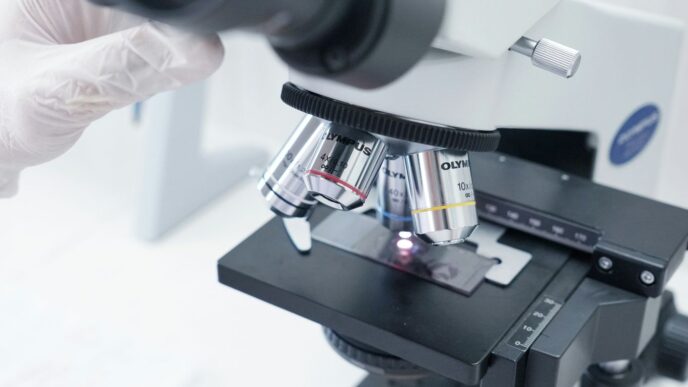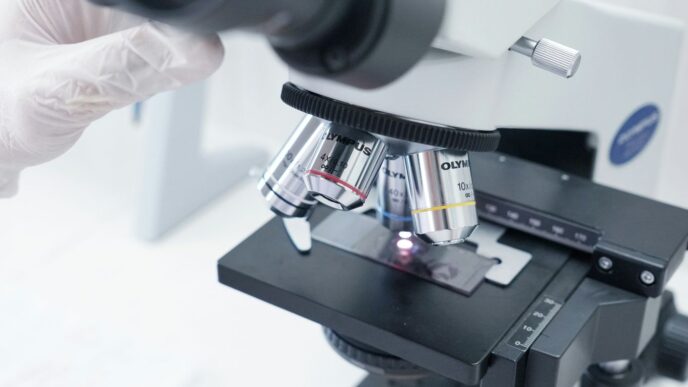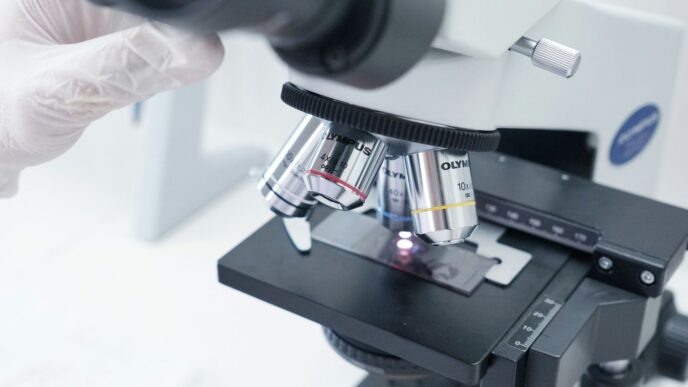Thinking about becoming a biotech software engineer in 2025? It’s a great time to jump in. This job sits right at the intersection of biology and computer science, and the demand just keeps growing. Whether you’re finishing school, switching from another STEM field, or just curious about where to start, there’s a lot to learn. But don’t worry—breaking into this field is totally doable if you know what steps to take. Here’s what you need to know to get your biotech software engineering career off the ground.
Key Takeaways
- Biotech software engineers blend biology and coding to solve problems in healthcare, research, and beyond.
- Getting started often means a degree in a science or engineering field, but online courses and certifications can help you stand out.
- Learning programming languages like Python, R, and SQL is important, along with understanding data security and cloud tools.
- Hands-on experience from internships, research, or personal projects makes your resume stronger and shows what you can do.
- Building a network through conferences, online platforms, and mentorship can open doors and help you grow in your career.
Understanding the Role of a Biotech Software Engineer

Bridging Biology and Technology
A biotech software engineer sits at the crossroads of science and engineering. You’ll be turning messy, real-world biology problems into working software—tools that help researchers and clinicians examine genomes, automate lab work, or sift through mountains of experimental data. This job isn’t just coding in a bubble; you might meet with lab folks on Monday, talk shop with data scientists on Wednesday, and troubleshoot something weird by Friday. If you ever thought science was all pipettes and Petri dishes, this role will surprise you. It’s about translating the daily chaos of the lab into clear, useful programs—sometimes working solo, and often as part of a mixed team of scientists and technologists. Some engineers even join established teams through platforms like Elevator, where collaboration is key to moving between biotech companies as a unit.
Typical Responsibilities and Impact Areas
Don’t expect to be bored, because your daily tasks will jump between problem-solving, collaboration, and experimenting with new technology. These are a few common focus areas:
- Building and maintaining tools for gene sequencing or data visualization
- Automating tasks that used to be performed manually in the lab
- Connecting instruments and databases to make sure experimental data flows smoothly
- Keeping regulatory and compliance needs in mind, such as data privacy rules
- Fixing bugs or updating features based on feedback from scientists
Here’s a snapshot of typical responsibilities versus their impact:
| Responsibility | Impact |
|---|---|
| Laboratory Automation Coding | More experiments, faster |
| Data Management Systems | Improved data reliability |
| Visualization Tools | Easier scientific insights |
| Workflow Integration | Fewer manual errors |
In-Demand Technical and Scientific Skills
To stand out, it helps to know what’s popular with hiring teams—and what actually gets used on the job:
- Programming languages: Python, Java, and R get used the most, especially for bioinformatics.
- Understanding of bioinformatics tools and databases, like BLAST, FASTA, or NCBI—these come up all the time.
- Comfort with SQL or other database languages for handling large experiment datasets.
- Basic grasp of molecular biology, biochemistry, or genetics (you don’t have to be a scientist, but you should follow the logic).
- Teamwork and communication skills, especially if you’re jumping between tech and biology groups
The truth is, this role’s for anyone who finds tech solutions satisfying and wants to make their mark on healthcare or life sciences—without giving up a love for code.
Educational Pathways for Aspiring Biotech Software Engineers
Getting into biotech software engineering is not a straight line—you’ve got options to piece together your education and skills. Some folks come in from hardcore biology, others from pure software backgrounds, and more from somewhere in between. Here’s how you can set yourself up for a solid start in 2025.
Foundational Degrees and Specialized Courses
Most people begin with a bachelor’s degree in computer science, bioinformatics, biotechnology, or a related field. But honestly, nobody’s gatekeeping here; it’s pretty common for career changers to get in with a creative mix of courses and experience, thanks to new educational trends highlighted by emerging technologies.
Here’s a quick look at what degrees and specialized classes can open the door:
| Degree Type | Typical Focus | Career Readiness |
|---|---|---|
| BSc in Bioinformatics | Genomics, Programming, Data Science | High |
| BSc in Computer Science | Algorithms, Coding, Databases | Medium (add bio later) |
| MSc/PhD in Biotechnology | Lab Methods, Advanced Biology | High for R&D, moderate for coding |
| Certs in Data Science/Bioinformatics | Python, R, AI for biology | Great for skill upgrade |
Useful Undergrad or Grad Classes:
- Intro to Molecular Biology
- Biostatistics
- Data Structures & Algorithms
- Bioinformatics Algorithms
- Cloud Computing Basics
Certifications and Lifelong Learning
Let’s face it—the biotech world never sits still. Keeping up means learning for the long haul:
- Online certificates (like those on Coursera or edX) in topics like machine learning, bioinformatics, regulatory affairs, or even lab automation.
- Workshops, seminars, and webinars—especially those run by industry leaders or academic centers. They keep you up to speed with what’s coming next.
- Short courses on new programming languages or approaches (think Python for genomics, or a crash course in Next-Gen Sequencing analysis).
Here’s a quick checklist of topics you’ll likely need, whether you’re updating skills or shifting focus:
- Programming for biological data analysis (Python, R, SQL)
- Cloud and data infrastructure (AWS, Azure basics)
- Ethics, privacy, and security—getting familiar with HIPAA or GDPR if you’ll touch patient data
Transitioning from Other STEM Fields
Biotech is super open to people who didn’t start there. If you’re coming from chemistry, physics, engineering, or regular old computer science, you’re not locked out—just be ready to fill a few gaps. Here’s how folks usually do it:
- Take targeted courses in biology (sometimes even free online ones do the trick).
- Pick a portfolio project that glues software with real biological or healthcare data. Even a semester-long side project can convince employers.
- Find internships, research assistant gigs, or short placements with a biotech focus—real lab or clinic experience always teaches you stuff a classroom doesn’t.
Bottom line: It’s not about ticking a rare set of boxes, but about showing you’re curious and can keep learning, no matter where you started. The biotech space in 2025 values people who aren’t afraid to retool and roll with industry changes.
Emerging Technologies Shaping Biotech Software Engineering
The biotech industry keeps pushing boundaries every year. Today, software engineers in this field need to understand not just code, but how new tools and technologies are changing the way science is done. Keeping up with these shifts can set you apart when you’re looking for a job or hoping to move forward in your career. Let’s take a closer look at some of the main trends picking up steam in 2025.
Artificial Intelligence and Machine Learning Applications
AI and machine learning aren’t just buzzwords in biotech—they’re actively changing how experiments are designed, how drugs are discovered, and how genetic data is analyzed. If you’re thinking about this career, consider these areas:
- Predictive analytics: Algorithms are now predicting which drug compounds are most likely to succeed, cutting down the time and cost of research.
- Image analysis: ML helps with everything from counting cells to flagging unusual results in microscopy data.
- Natural language processing: AI systems read piles of research papers and clinical data, highlighting trends and possible new research targets.
A few ML technologies worth knowing:
| Technology | Use Case Example |
|---|---|
| Deep Learning | Protein modeling, gene mapping |
| Random Forests | Clinical trial outcome prediction |
| Reinforcement Learning | Robotic lab processes |
Lab Automation, Robotics, and IoT Integration
Manual lab work is not what it used to be. Now, robots and sensors are everywhere. Software engineers get to write code that manages these tools and makes sense of the massive piles of data they spit out.
Some ways this is showing up:
- Automated sample handling: Robots move thousands of samples faster than a person ever could.
- Remote monitoring and control: Internet-connected (IoT) equipment allows techs to monitor reactions or adjust conditions from anywhere.
- Integration with ELNs: Cloud-based Electronic Lab Notebooks mean experiment data is easier to store, share, and analyze safely.
Single-Cell Analysis and Multi-Omics Data
Gone are the days of looking at averages across millions of cells. With single-cell sequencing, researchers can study the unique story of every cell in the sample. But this means way more complex data for software engineers to manage.
Here’s what this means for software projects:
- Data pipelines: Code must sort, clean, and annotate data from thousands of cells—sometimes across DNA, RNA, proteins, and metabolites all at once.
- Visualization: With so many data layers, intuitive visual tools help researchers pinpoint interesting cells or patterns.
- Security and compliance: Sensitive medical and genetic information needs protected pipelines and strong privacy features.
Bottom line: If you want your code to matter in biotech, focus on how these technologies shape daily lab work and research breakthroughs. Stay curious, experiment with new tools, and don’t be afraid to learn from mistakes—this field rewards those who adapt quickly.
Essential Coding and Analytical Skills for the Biotech Industry
You can’t get very far in biotech software engineering without solid coding skills, but that’s just the beginning. These days, it’s more about how well you can mix programming with a real sense of what’s happening in a lab or with clinical data. Let’s break this down.
Most Valuable Programming Languages
Every biotech software engineer needs a handle on at least one or two languages. Here’s a quick run-down that’s pretty standard in 2025:
| Language | Main Use | Typical Tools/Libraries |
|---|---|---|
| Python | Data pipelines, AI/ML, automation | Pandas, Biopython, TensorFlow, PyTorch |
| R | Statistical analyses, genomics | ggplot2, Bioconductor |
| SQL | Database wrangling | Standard SQL, PostgreSQL, MySQL |
| SAS | Clinical trials, regulatory | Base SAS, SAS/STAT |
| Java/C++ | Lab automation, platform dev | Custom libraries, hardware APIs |
Python is the go-to language because it’s flexible and has strong libraries for biology and data.
Bioinformatics Pipelines and Data Management
Knowing how to code isn’t enough—you’ve got to show you can build things that handle real scientific data. Here’s what helps:
- Create or modify bioinformatics pipelines to clean, process, and analyze sequencing data.
- Use and understand open-source tools and standard file formats (think FASTQ, SAM/BAM, VCF).
- Learn how to use workflow managers like Nextflow or Snakemake for reproducibility.
- Databases matter: You’ll need to be comfortable storing and retrieving data in structured formats using SQL or NoSQL databases.
- Get experience managing large datasets and figuring out ways to keep everything organized and accessible for your teammates.
Cloud Computing and Data Security Standards
Most biotech startups and companies moved to the cloud years ago, and security requirements just keep rising. Here’s what’s standard now:
- Understand how to use AWS, Google Cloud, or Azure for storing and processing genomics or clinical data—this is non-negotiable.
- Know how to make automated data pipelines using tools like AWS Lambda or Google Cloud Functions.
- Get familiar with the basics of HIPAA and other data protection rules because you can’t risk patient or project data being exposed.
A few extra points you might want to consider:
- Learn how to work with encrypted datasets and manage access controls on shared folders.
- Practice documenting your code and pipelines so anyone can pick up where you left off (this really helps in teams).
- Make sure you understand version control (like git), because collaboration means tracking changes.
In practice, the biotech industry wants to see you apply coding and data skills directly to biology and healthcare problems. Build those links with practical, hands-on projects—or in whatever real-world scenario you can find—and you’ll stand out.
Gaining Real-World Experience in Biotech Software Engineering
No matter how much theory you soak up, most hiring managers want to see real examples of what you’ve actually built or contributed to in the biotech space. Getting hands-on experience matters more than just memorizing facts for an exam. Here are some of the most effective ways to build practical skills and make your resume stand out.
Finding Internships and Research Projects
Internships are probably the best way to see what everyday biotech software problems look like. But they’re also one of the toughest things to find if you’re just starting out. Try these steps:
- Ask professors and lab managers if they know of any open positions—sometimes roles pop up and never get advertised formally.
- Check company careers pages and keep a running list of biotech companies in your area.
- Cold email research groups or startups with a short introduction and specific interest (mention recent company research if you can).
A lot of students skip smaller labs or little-known startups, but those spots often have you doing real coding, not just fetching coffee.
Example Internship Roles Table
| Type of Internship | Common Tasks | Best Time to Apply |
|---|---|---|
| Academic Research Labs | Building scripts and data dashboards | Winter/Spring |
| Biotechnology Startups | Coding prototypes, handling genomics data | Rolling |
| Large Pharma/Biotech Companies | Maintaining databases, fixing analysis tools | Oct–Jan |
Open Source and Personal Portfolio Projects
If you can’t land an internship right away, don’t wait around. Open source projects are a great way to practice coding and get your name out in the community. This could be:
- Contributing to bioinformatics software used in real research
- Uploading your scripts or apps to GitHub and documenting what they do
- Working with health data to create data visualizations or cleaning tools
Make sure you finish what you start—even a small completed project can say more than a collection of half-finished ideas. Showing the full workflow, from data wrangling to final insights, can stand out way more than you think.
Leveraging Hackathons and Innovation Challenges
Hackathons aren’t just for fun—they’re time-limited coding sprints where you team up (often with strangers) to solve real biomedical challenges. The best part? You get instant feedback from mentors in the field.
Here are some ways hackathons help your biotech software engineering journey:
- Rapidly pick up practical teamwork and coding under real deadlines
- Work with datasets or APIs actually used in research or medical settings
- Sometimes your project may catch a recruiter’s or professor’s eye for future collaboration
Plus, winning or even just participating in these events gives you strong examples to mention in interviews (not to mention a few stories about what went wrong and how your team kept it together).
Some of the newer hackathons now ask teams to use emerging tech—like running diagnostics over cloud platforms, or building systems to secure health data in line with current cloud computing security standards.
All in all, whether your path is in industry, research, or startups, practical experience in biotech software engineering builds confidence and provides clear proof of your skill set. Anyone can say they ‘know Python,’ but showing you automated a genomics workflow or helped a team submit results to a hackathon? That’s where you really stand out in 2025.
Building Professional Networks and Showcasing Your Work
Developing connections and making your achievements visible is a smart way to move forward in biotech software engineering. Your skills and experience matter, but the people you know—and those who know your work—often open up the best opportunities. Here’s how you can do this:
Industry Conferences and Meetups
Going to conferences and local biotech events might seem a bit intimidating at first, but it’s one of the easiest ways to talk to people who actually work where you want to be. You get exposed to new research, see what’s popular in the industry, and sometimes even spot a job booth or two. To get the most out of these events:
- Start by attending regional or virtual gatherings if travel costs are a blocker.
- Prepare 1-2 sentences about what you’re working on or learning—people will ask.
- Don’t be shy about following up on LinkedIn after meeting someone interesting.
Online Presence and Technical Portfolios
These days, lots of recruiters look you up online before sending an email. Having a basic profile and a simple portfolio puts you miles ahead of others who don’t bother. Here’s what helps:
- Create a LinkedIn page that actually lists your skills and projects.
- If you code, put your best scripts, Jupyter notebooks, or data pipelines on GitHub or a similar site.
- Write about project results on a personal blog, or even summaries of big problems you solved during a hackathon.
A side benefit? Writing clear documentation can actually help you refine your thinking—plus it shows you know how to communicate, which is a big plus in any research-driven team.
Academic-Industry Collaborations and Mentorship
Some of the most interesting projects and job offers come through partnerships between universities and biotech firms. You don’t always need to be a grad student; sometimes, companies want coders for summer research or small, grant-funded pilots. If you’re in school:
- Ask your professors if they have industry partners or know any alumni in biotech roles.
- Look for university newsletters about industry-sponsored programs.
- Try reaching out politely to someone at a company you admire for a 15-minute informational chat (most won’t reply, but some might).
Finding a mentor isn’t just about asking someone to be your mentor—it’s about reaching out with specific questions or asking for advice. And when someone does help you, send a quick thank-you note or an update. It’s polite and keeps you in their mind for the future.
Networking and showing off your work can feel awkward at first, but the more you do it, the easier it becomes—and the more doors it can open in biotech software engineering.
Career Progression and Specialization Paths in Biotech Software

There are many different paths you can take as a biotech software engineer, and none are exactly the same as someone else’s. Sometimes it feels like there’s a new specialty popping up every month. New grads may start out writing code or fixing bugs, but with time, you can take on more challenging roles, lead projects, or even launch a business.
From Entry-Level to Leadership Roles
Most people start in technical roles, then move into leadership as they gain experience. Here’s what the usual ladder looks like:
| Level | Typical Job Titles | Key Focus Areas |
|---|---|---|
| Starter | Junior Developer, Data Analyst | Coding, bug fixes, writing scripts |
| Mid-Career | Software Engineer, Bioinformatician | Managing small projects, mentoring juniors |
| Senior | Senior Engineer, Team Lead | Project strategy, onboarding new hires |
| Leadership | Engineering Manager, CTO | Vision, hiring, resource management |
Everyone’s path is unique, but some steps are pretty common. You’ll probably spend at least a couple years learning the ropes before you manage bigger pieces of the work.
Focusing on R&D, Clinical Trials, or Digital Health
As you get more experience, picking a specialty makes a big difference. Some common areas to focus on:
- Research & Development (R&D): You’ll work alongside scientists, building tools for gene editing, protein design, or cell imaging.
- Clinical Trials Tech: Code for secure patient-data systems, create software to analyze trial results, or automate the paperwork.
- Digital Health: Build mobile apps or digital therapeutics, or work on AI for medical devices.
Picking a focus can help you become the go-to person for certain types of projects. Over time, you might even move into hybrid jobs that combine coding with product management, regulatory work, or data science.
Entrepreneurship and Startup Opportunities
The biotech startup scene is growing every year. People with coding skills and science backgrounds are in demand to:
- Build MVPs (Minimum Viable Products) for exciting new health tech ideas.
- Launch platforms for drug discovery, diagnostics, or patient monitoring.
- Lead small teams or become co-founders, handling both the tech side and business conversations.
Being at a startup can be chaotic—sometimes you’re writing code, other days you’re heading to investor meetings or rewriting your pitch. Expect long hours, quick pivots, and lots of learning on the fly. But, for some, it’s the fastest way to get noticed or even make a real impact.
No matter what route you take, biotech software engineering can be a lifelong career, not just your first job after college. You just need to be open to change (because the field is always shifting) and keep picking up new skills as the science and the code move forward.
Conclusion
So, that’s the big picture for anyone thinking about jumping into biotech software engineering in 2025. The field is changing fast, and there’s a lot to keep up with, but that’s also what makes it exciting. If you’re just starting out, focus on learning the basics—coding, biology, and how they fit together. Don’t worry if you don’t know everything right away. Most people learn as they go, picking up new skills on the job or through side projects. Try to connect with others in the field, whether it’s through online groups, meetups, or just reaching out to someone whose work you admire. The more you talk to people, the more you’ll learn what’s really happening in the industry. And remember, biotech isn’t just about making money or building cool tools—it’s about solving real problems that affect people’s lives. If you stay curious and keep learning, you’ll find your place in this growing field. Who knows, maybe you’ll help build the next big thing in biotech.
Frequently Asked Questions
What does a Biotech Software Engineer do?
A Biotech Software Engineer helps connect biology and computer science. They write code and make tools that help scientists study genes, create new medicines, or run lab machines. Their work makes it easier to handle big sets of science data and speed up research.
What should I study to become a Biotech Software Engineer?
You should start with a degree in computer science, biology, biotechnology, or a similar subject. Learning to code is very important—languages like Python and R are good choices. You can also take extra classes online or get certificates in bioinformatics or data science.
Is it hard to switch to biotech software from another STEM field?
No, it’s not too hard if you already know how to code or have a science background. You just need to learn some basic biology or coding, depending on what you know already. Joining projects, taking online courses, or helping with research can help you make the switch.
Which programming languages are most useful in biotech?
Python, R, and SQL are the most popular languages in biotech because they help with data analysis and building tools. Sometimes, you might also use Java, C++, or cloud tools, but starting with Python and R is best for beginners.
How can I get real experience before my first job?
You can look for internships at biotech companies or research labs. Joining open-source projects or building your own coding projects related to biology also helps. Hackathons and science competitions are great ways to practice and meet people in the field.
What is the future of biotech software engineering?
The future is bright! New tech like AI, lab robots, and big data is changing how science works. Biotech software engineers will be needed to build smart tools, help with personalized medicine, and work on exciting new discoveries. If you keep learning and stay curious, you’ll have lots of opportunities.














